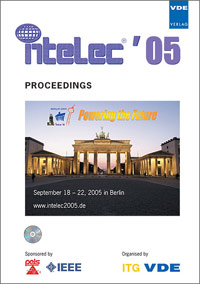System Integration of Lithium-Ion battery in Telecommunication Back-up Power Plant
Conference: Intelec '05 - Telecommunications Conference - 27th International Telecommunication Energy Conference
09/18/2005 - 09/22/2005 at Berlin, Germany
Proceedings: Intelec '05 - Telecommunications Conference
Pages: 6Language: englishTyp: PDF
Personal VDE Members are entitled to a 10% discount on this title
Authors:
Ng, Patrick K.; Mathiesen, Gregory; Davis, Roy (Tyco/Electronics Power Systems, 3000 Skyline Dr, Mesquite, TX 75149, USA)
Abstract:
The development and manufacturing of lithium-ion batteries have matured to the point that large form factor batteries are available for applications in the telecommunications industry. These batteries offer the advantage of much high energy density than lead acid battery, both in terms of weight and volume. They do not emit hydrogen gas and have a low steady state float current that is independent of battery temperature. The possibility of thermal runaway caused by higher float current at higher temperature is greatly reduced. Safe operation of the lithium-ion battery relies on protection features incorporated inside the battery pack. Internal protection features may include cell balancing, current limiting, contactor, and slow blowing fuse. In telecommunication back-up applications, the lithium-ion battery is a component of a power plant that includes rectifiers, controller, distribution panels, and different sizes of cables. It is imperative to have the lithium-ion battery integrated seamlessly into the power plant and sufficient system integration testing be done to ensure the smooth and safe operation. In this paper, test results will be presented on issues that are critical to the integration of lithium-ion battery within a power plant. The situation of mixing lithium-ion battery with other types of battery in the power plant will also be presented.


